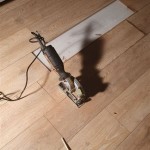How To Install Laminate Flooring On A Concrete Floor
Laminate flooring has become a popular choice for homeowners due to its affordability, durability, and ease of installation. It's a great option for anyone looking to update their floors without breaking the bank. If you're looking to install laminate flooring over concrete, this guide will provide you with a comprehensive step-by-step process.
Before you begin, ensure you have gathered all the necessary tools and materials such as a tape measure, a utility knife, a circular saw, a hammer, a level, a pencil, a moisture barrier, an underlayment, a tapping block, and spacers.
Preparing The Concrete Floor
The success of your laminate flooring installation lies in properly preparing your concrete floor. A well-prepared surface ensures a smooth and even installation. Firstly, you must clean the concrete floor thoroughly. This involves removing dirt, debris, grease, and any other substances that may hinder the flooring's adhesion. Use a broom and vacuum to remove loose dust and debris. Next, use a cleaning solution specifically designed for concrete to eliminate grease, oil, and other stains.
Secondly, you will need to assess the floor for any cracks, holes, or uneven surfaces. If you notice any significant cracks or holes, you should repair them using concrete patching compound. Once the patching compound has dried, sand the area smooth to create a seamless transition. If the concrete floor is uneven, you may need to use a self-leveling compound to achieve a level surface.
Finally, you need to ensure your concrete floor is adequately dry. Moisture can damage laminate flooring, so it is essential to check the moisture content. If you discover high moisture levels, consider using a dehumidifier or hiring a professional to apply a moisture barrier. This barrier will prevent moisture from migrating up to the laminate flooring.
Installing The Underlayment
Underlayment is a crucial component of laminate flooring installation. It acts as a cushion, providing sound insulation, and helps to absorb minor unevenness in the substrate. The most common types of underlayment for laminate flooring are foam, cork, and felt underlayment.
Start by laying down the underlayment in the direction of the laminate planks. Ensure that the underlayment sheets are butted tightly together, with no gaps or overlapping. You can use a utility knife to cut the underlayment to fit the room's shape. Secure the underlayment using staples or tape, depending on the type of underlayment used.
It is essential to follow the manufacturer's instructions for installing the underlayment. This may include specific guidelines for overlapping, fastening, and sealing.
Installing The Laminate Flooring
Installing the laminate flooring is the final step. The process is straightforward and typically involves a click-and-lock system. You can start by laying the first row of laminate planks along the longest wall. Be sure to leave a 1/4 inch expansion gap between the flooring and the wall. This allows for the planks to expand and contract due to changes in temperature and humidity.
Use a tapping block and hammer to secure each plank into place. Lay the next row of planks, ensuring that the joints are staggered. Use a spacers to maintain the 1/4 inch expansion gap around the perimeter of the room. Continue installing the planks in a row-by-row fashion.
Common Mistakes To Avoid
While installing laminate flooring on a concrete surface is relatively simple, there are some common mistakes to avoid.
Insufficient Preparation
Failing to properly prepare the concrete floor is a common mistake. Ensure the floor is clean, level, and dry. Any cracks or unevenness left unaddressed will result in uneven flooring and potential damage to the planks.
Improper Installation
Not following the manufacturer's instructions can lead to installation problems. Properly installing the laminate floor is essential. Always ensure each plank is locked into place and avoid gaps or loose planks.
Ignoring Expansion Gaps
It is crucial to leave a 1/4 inch expansion gap around the perimeter of the room between the flooring and the wall. Failing to do so can lead to swelling and buckling of the flooring.
Installing laminate flooring on a concrete floor is a rewarding DIY project. By following these steps and understanding the common mistakes to avoid, you can achieve a successful installation and enjoy a beautiful and durable floor for years to come.

How To Install Vinyl Or Laminate Floors In A Basement Over Concrete Slab

Laminate Flooring On Concrete Basement Floors Expert Installation Guide Csg Renovation

Installing Laminate Flooring Over Concrete The Ultimate Guide Aa Floors

Installing Wood Flooring Over Concrete Diy

How To Install Laminate Over Concrete Day 1

How To Install Laminate Flooring Over Concrete

Lvp Flooring Installation How To Install Luxury Vinyl Plank In A Basement Diy

How To Install Laminate Flooring On Concrete Making Maanita

How To Lay Laminate Flooring On Concrete Howtospecialist Build Step By Diy Plans Laying Installing

Installing Pergo 4 In 1 Transitions On Concrete With No S
See Also







